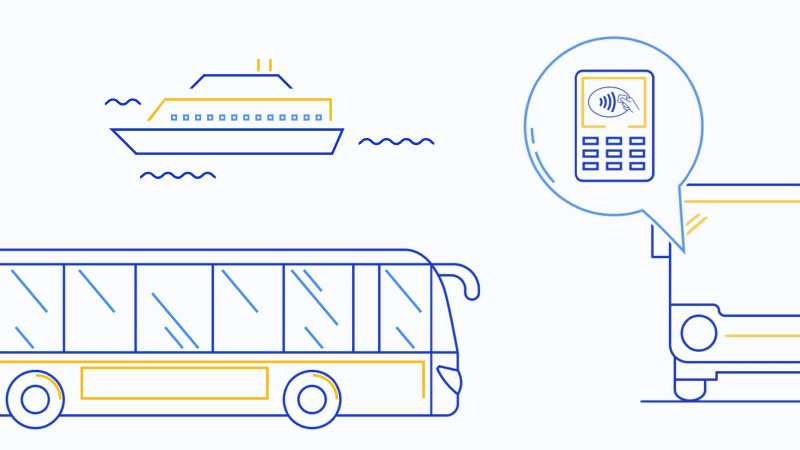What's next in urban mobility
Contactless payments have made transit more seamless. Here’s a peek at what’s next.

Imagine a future where, anywhere in the world, you ride public transit without reaching for your wallet or phone. The bus, train or ferry system just ‘knows’ you’re there.
This ‘hands-free’ future is perhaps not far off. And it may surprise you to know that it shares a common architecture with open-loop contactless ‘tap-to-ride’ technology which is increasingly prevalent the world over.
Contactless payments have already transformed more than 750 transit systems globally making tap-to-ride commonplace in forward-looking cities around the world. Visa’s recent Future of Urban Mobility study1 found that 94 percent of transit riders expect public transit to offer contactless payments — where they can use their card or smart device to quickly pay for their fare. And of transit agencies that do not currently have open-loop technology, 83 percent plan to implement it — 70 percent within the next two years.2
Open-loop contactless technology is underpinned by Account Based Ticketing (ABT) architecture, which places the ‘brains’ of the system in a central host system, sometimes referred to as the ‘back-office’. This is different to Card-Based Ticketing where the ‘brains’ reside in the smart cards themselves. We are seeing growing momentum for ABT, driven at least in part by open-loop contactless, in all corners of the world, which is setting the direction of travel for the industry.
ABT architecture is considered the next-generation of transit ticketing, and it has the potential to radically advance the way we get onboard our transport systems, leveraging a virtually unlimited range of technologies, from biometrics to Bluetooth, and from geofences to ultrasonic data!
So how can agencies new to open-loop — and ABT for that matter — meet consumer expectations today while future-proofing their tech stacks for this bright future of innovation? And how can agencies that have already implemented open-loop continue to augment passenger experiences that are seamless and secure?
Here's a look at what’s next in transit payments around the world — now, in the near term, and a few years out.
1. Bolder, faster open-loop system launches
As I mentioned, contactless payments have moved from being ‘nice-to-have’ to ‘need-to-have’. Visa has helped launch tap-to-ride in more than 750 transit systems worldwide, contributing to lower ticketing overheads for public and private transportation operators (down 30%)3, ridership growth (by 9.5%)4 and improved passenger experiences (often exceeding customer satisfaction levels of Card Based Ticketing).
Having learned from these hundreds of implementations over the years, Visa has developed a range of solutions that help to bring new transit systems online more quickly and with bolder outcomes than before. In the past year, more than 40 percent of transit system launches Visa helped included Visa Acceptance Platform, which enables partners to choose the services they need to deliver world-class customer experiences based on ABT architecture, when they need them.
2. MaaS will come to the masses
Right now, paying for public transit can still be a fragmented experience in many cities. In fact, to get from one place to another, the majority of public transit riders use four or more payment methods per month. Mobility as a Service (MaaS) aims to fix that.
At its core, MaaS is about breaking-down barriers and integrating services, empowering individuals, regardless of age, ability, or socioeconomic status, to move from point A to point B, in the most convenient way possible. When MaaS reaches its full potential, riders will be able to leverage their favorite app to plan seamless multimodal travel. Want to take the greenest route? Quickest route? Most scenic route? Punch in your needs, review payment options and off you go.
By embracing MaaS, another example of ticketing that is underpinned by ABT, cities and mobility providers will be able to offer personalized, flexible and on-demand mobility options that cater to individual needs, helping to foster trust, loyalty, and, ultimately, higher ridership and customer satisfaction.
3. Transit agencies will play to their core strengths
Transit agencies are experts in the field of running transit services, not payments. They need partners who can help them keep pace with the rapidly evolving payments landscape, while providing the necessary connectivity to a certified partner ecosystem, and delivering services that weed out costs and boost profitability. That’s where Visa comes in — with scale, security and experience bringing payments experiences to life. We are helping free-up transit agency resources that let them play to their core strengths, liberating the full potential of urban mobility in alignment with their policies and ambitions.
4. Emerging technology provides more intuitive experiences
Agencies around the world are exploring various new technologies with the potential to enable “hands-free” travel, which we sometimes refer to as ‘Be In, Be Out’ (or BIBO). Technologies ranging from Radio Frequency (RF) beacons (think Bluetooth or Ultra Wide-Band, UWB), ultrasonic data communications, geo-fencing and various biometric capabilities (think fingers, hands, faces) could all play a part in the longer-term future of transit. And, again, these technologies will hinge on ABT architecture to flourish. So, while it’s quite a leap to move from paper tickets to “hands-free,” open-loop contactless payments are a concrete step in the right direction.
Learn more about Mobility as a Service (MaaS) and Global Urban Mobility at Visa.
2 https://usa.visa.com/content/dam/VCOM/regional/na/us/sites/documents/veei-reimagining-ridership.pdf
4 VEEI and ThoughLab survey of transit agencies and cities (2022); FTA (2022b)